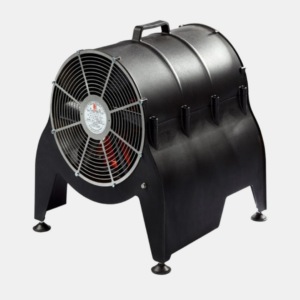Explosion-proof lighting is an essential way to meet your health and safety obligations in hazardous areas, including zones where explosive gases, vapours and dusts are routinely present.
Whether the risk is a constant one, or is only occasional, having the correct hazardous area lighting in place allows you to carry out work without needing to worry about removing hot lights and unshielded electrical equipment from the area.
The Health and Safety Executive’s COMAH Guidance on Hazardous Area Classification and Control of Ignition Sources identifies “electrical equipment and lights” as a potential source of ignition.
It adds: “Sources of ignition should be effectively controlled in all hazardous areas by a combination of design measures [and by] using electrical equipment and instrumentation classified for the zone in which it is located.”
What is explosion-proof lighting?
Explosion-proof lighting is professionally certified hazardous lighting under certification schemes like ATEX, IECEx and NEC, which allows you to buy products that are rated for your hazardous areas.
The category of hazardous area lighting you need depends on the type of explosive material present, and how continuously the explosion-risk occurs.
Gas hazardous areas
Zone 0: Explosive gases are present constantly or for extended periods of time.
Zone 1: Explosive gases are present occasionally under normal conditions.
Zone 2: Explosive gases are present infrequently for short periods.
Dust hazardous areas
Zone 20: Explosive dusts are present continually or for long periods of time.
Zone 21: Explosive dusts are present some of the time under normal conditions.
Zone 22: Explosive dusts are present infrequently for short periods.
In general, it is sensible to choose the highest level of protection that any given hazardous area might need – there is no harm in being overly cautious.
Where are explosion-proof lighting fixtures used?
There are some industrial environments where explosion-proof lighting fixtures are clearly necessary, for example on oil rigs, gas refineries and coal mines, but this is only one small portion of their use.
Hazardous area lighting covers a wide range of applications, including:
Hazardous lights can be mounted in almost any position, from ceiling-mounted and linear lighting, to wall-mounted and bulkhead lights, and portable ground-level or handheld lights.
As a result, explosion-proof lighting fixtures can be used in almost any industry where gas, vapour or dust may be present, including laboratories, fabrication workshops, food and beverage production, and textiles warehouses.
Reasons for using explosion-proof lighting in hazardous areas
Explosion-proof lighting is clearly a sensible precaution in hazardous areas where there is a risk of ignition when using conventional lighting fixtures.
However, hazardous lighting offers a range of other benefits, including:
Eliminating chances of catastrophic accidents
An explosion is one of the most instantly catastrophic incidents that can occur in any workplace or residence, with the potential to cause significant loss of life and property damage.
The protection provided by installing correctly certified explosion-proof lighting cannot be overstated, and may be required by health and safety regulations in high-risk hazardous areas.
Peace of mind
Peace of mind comes not only from having trust in your safety precautions, but also in being able to properly light up your hazardous areas, which in itself is an important way to reduce the risk of injuries and other incidents.
Hazardous lighting offers bright, reliable illumination, allowing personnel to work with confidence when handling potentially hazardous and explosive materials. This is crucial for round-the-clock facilities, but also for any interiors where artificial lighting is required at all times.
High ROI
Your investment in ex-proof lighting can pay for itself over time. While this might sound surprising, installing the right explosion-proof lighting upfront can reduce running costs and negate the need for further hardware at a later date.
Just some of the ways hazardous lighting achieves this:
- Rugged, reliable lighting needs less maintenance and repair work.
- No need to spend on retrofitting explosion-proof enclosures around lights.
- Avoid costs due to incidents ranging from repairs to compensation.
All of this is in addition to the safety benefits and regulatory compliance of installing hazardous area lighting, making a compelling all-around business case.
ATEX certification
ATEX certification, and its equivalents in other parts of the world, give you confidence that your lighting meets a minimum standard of safety, measured against stringent and consistent criteria.
This in turn allows you to protect your most high-risk hazardous areas (including Zone 0 and Zone 20) and offer reassurance to employees and stakeholders alike.
Reasons to choose LED explosion-proof lights
Since August 2023, the manufacture of T5 and T8 fluorescent tubes has been banned in EU member states. LED lighting has been the main choice for hazardous areas for some time already, but the new legislation means the focus is even more on LED explosion-proof lights for the future.
LED luminaires for explosion-risk areas make good sense, because they tend to run at a much lower temperature than other lighting technologies. They also do not contain mercury, which means that – unlike the now-outlawed fluorescent tubes – they do not introduce an additional hazardous material into your working environment.
In addition to this, LED exp lights use less energy, last for longer with little to no maintenance, and save on costs and carbon. For all of these reasons, LED explosion-proof lights will be the go-to choice for harsh, hazardous and industrial areas in the future.

Conclusion
Across the board, hazardous area lighting offers regulatory compliance, protection for property and personnel, and a strong financial argument for investing upfront in the highest-quality explosion-proof lighting available for your premises.
Best of all, this is a ‘one and done’ decision. Once in place, your hazardous lighting will, by its very nature, continue to provide protection and avoid repair and maintenance costs for years to come – so the sooner you install it, the greater the ROI.











